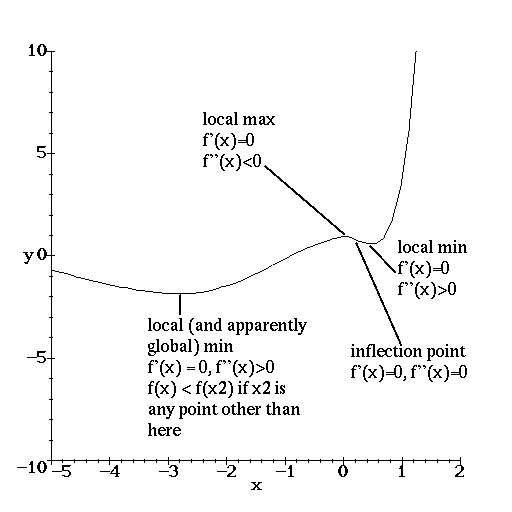Now lets put all this stuff to use by utilizing derivatives to locate
all of the local maxima and minima of a function. A local maxima is a
point (x,f(x)) such that, for any point ![]() that is sufficiently close
to x, the condition
that is sufficiently close
to x, the condition ![]() is satisfied. Thus, locally, the
point (x, f(x)) is the highest point. Similarly, a local minima is a
point which is lower than the surrounding points. To locate extrema such
as these, we use our knowledge of derivatives. If a point (x, f(x)) is
the maximum of f(x), then f'(x) = 0. If this were not
true, then the slope would be either positive or negative, and by moving
forward in x (or backward if the slope is negative) we could reach a
higher point on the function since the slope is nonzero. This also holds
for a point which is a minimum.
is satisfied. Thus, locally, the
point (x, f(x)) is the highest point. Similarly, a local minima is a
point which is lower than the surrounding points. To locate extrema such
as these, we use our knowledge of derivatives. If a point (x, f(x)) is
the maximum of f(x), then f'(x) = 0. If this were not
true, then the slope would be either positive or negative, and by moving
forward in x (or backward if the slope is negative) we could reach a
higher point on the function since the slope is nonzero. This also holds
for a point which is a minimum.
There is one sticky point, though. The derivative can be zero at a point that is not a maximum or a minimum. Thus, f'(x) = 0 is a necessary, but not sufficient condition for the point (x, f(x)) to be a local max or min. We can use the second derivative to help. If the function is concave up at the point where the derivative is zero, then the point must be a minimum. If the function is concave down, it is a maximum. If the second derivative is zero, then we have an inflection point.

Consider the function
![]()
We will now calculate the local extrema.
![]()

![]()
![]()
![]()
![]()